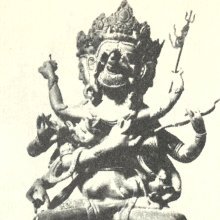Kapaladhara, Kapala-dhara, Kapāladhara, Kapāladharā: 6 definitions
Introduction:
Kapaladhara means something in Buddhism, Pali, Hinduism, Sanskrit. If you want to know the exact meaning, history, etymology or English translation of this term then check out the descriptions on this page. Add your comment or reference to a book if you want to contribute to this summary article.
Images (photo gallery)
In Hinduism
Shaivism (Shaiva philosophy)
Source: Google Books: Manthanabhairavatantram (shaivism)Kapāladhara (कपालधर) refers to “one who holds a skull” and represents one of the attributes of Svacchanda, according to the Śrīmatottara-tantra, an expansion of the Kubjikāmatatantra: the earliest popular and most authoritative Tantra of the Kubjikā cult. Accordingly, “O goddess, Svacchanda is in the middle, within the abode of the triangle. Very powerful, he has five faces with three times five flaming eyes. [...] O fair lady, my attributes—trident, dagger, sword, the king of the snakes, and rosary—adorn the right (arms). O beloved, a skull [i.e., kapāladhara], double-headed drum, javelin, noose and goad—(these) are my divine, brilliant and very auspicious weapons that (are held) in the left (hands). The king of snakes (hangs) on the shoulder and a garland of skulls hangs (from the neck). There is a necklace of scorpions around the throat and the ears are adorned with snakes. [...]”.
Source: SOAS University of London: Protective Rites in the Netra TantraKapāladhara (कपालधर) refers to “one holding a skull bowl” and is used to describe Bhairava, according to the Netratantra of Kṣemarāja: a Śaiva text from the 9th century in which Śiva (Bhairava) teaches Pārvatī topics such as metaphysics, cosmology, and soteriology.—Accordingly, [verse 10.1-7ab, while describing the appearance and worship of Bhairava]—“[...] He [is] mounted on a lion, wears a snake garland, bears a mālā, and begging bowl. [He has] a torn mouth from [which he emits] a great roar. [His body is] covered by a cloth of elephant skin, a flower crown, [and] the moon. [Bhairava] holds a skull-topped staff and skull bowl (kapāladhara—kapālakhaṭvāṅgadharaṃ). [...] Having worshipped Bhairava, [the Mantrin] remembers being joined in union [with] him, [in the same way as] dissolution in fire”.

Shaiva (शैव, śaiva) or Shaivism (śaivism) represents a tradition of Hinduism worshiping Shiva as the supreme being. Closely related to Shaktism, Shaiva literature includes a range of scriptures, including Tantras, while the root of this tradition may be traced back to the ancient Vedas.
Shaktism (Shakta philosophy)
Source: Google Books: ManthanabhairavatantramKapāladhara (कपालधर) refers to “one who holds a skull”, according to the Kularatnoddyota, one of the earliest Kubjikā Tantras.—Accordingly, [while describing the gross form of Navātman called Śabdarāśinavātman]: “(Navātman) has a big body and burns intensely, illumining the sky with (his) radiant energy. [...] He holds a skull [i.e., kapāladhara] and an ascetic’s staff. (Another) hand shines (as it were) with a trident. (He also holds) a bow, an arrow, vīṇā, bell and double-headed drum. [...]”.

Shakta (शाक्त, śākta) or Shaktism (śāktism) represents a tradition of Hinduism where the Goddess (Devi) is revered and worshipped. Shakta literature includes a range of scriptures, including various Agamas and Tantras, although its roots may be traced back to the Vedas.
In Buddhism
Tibetan Buddhism (Vajrayana or tantric Buddhism)
Source: OSU Press: Cakrasamvara SamadhiKapāladhara (कपालधर) refers to “one bearing a skull bowl” and is used to describe Mahākāla, according to the Kalaśa Pūjā [i.e., Kalasha Worship] ritual often performed in combination with the Cakrasaṃvara Samādhi, which refers to the primary pūjā and sādhanā practice of Newah Mahāyāna-Vajrayāna Buddhists in Nepal.—Accordingly, “Dark-blue colored, mounted on a corpse, a dharma protector, A lord bearing a knife and skull bowl (kapāladhara), Mahākāla, I give homage”.
Source: MDPI Books: The Ocean of HeroesKapāladharā (कपालधरा) refers to “she who holds a skull bowl in her hand”, according to the 10th-century Ḍākārṇava-tantra: one of the last Tibetan Tantric scriptures belonging to the Buddhist Saṃvara tradition consisting of 51 chapters.—Accordingly, [while describing the Adamantine Circle (vajracakra)]: “ [Every] Yoginī on all [twelve] circles—she [has] four arms, [has] one face, holds a skull bowl (kapāladharā) and a skull staff [kapālakhaṭvāṅgadharā] [in the two left hands], also [holds] a small drum and a knife [in the two right hands], [has her] hair untied, is naked, [has her] body [ornamented with] the five seals, is adorned with a string of vajras, stands on a corpse, and is very terrifying; [she] wears various [good] ornaments and is a wisdom accompanying a means (her male consort). [...]”.

Tibetan Buddhism includes schools such as Nyingma, Kadampa, Kagyu and Gelug. Their primary canon of literature is divided in two broad categories: The Kangyur, which consists of Buddha’s words, and the Tengyur, which includes commentaries from various sources. Esotericism and tantra techniques (vajrayāna) are collected indepently.
Languages of India and abroad
Kannada-English dictionary
Source: Alar: Kannada-English corpusKāpāladhara (ಕಾಪಾಲಧರ):—[noun] Śiva, who holds a skull and wears a garland of skulls.
Kannada is a Dravidian language (as opposed to the Indo-European language family) mainly spoken in the southwestern region of India.
See also (Relevant definitions)
Partial matches: Kapala, Dhara.
Starts with: Kapaladharana, Kapalataran.
Full-text: Kapalin.
Relevant text
No search results for Kapaladhara, Kapāla-dhara, Kapala-dhara, Kapāla-dharā, Kapāladhara, Kapāladharā, Kāpāladhara; (plurals include: Kapaladharas, dharas, dharās, Kapāladharas, Kapāladharās, Kāpāladharas) in any book or story.
